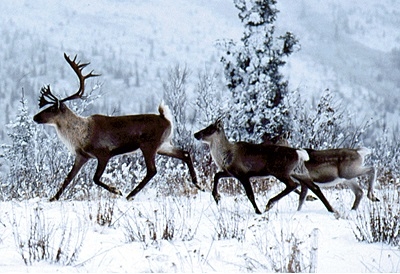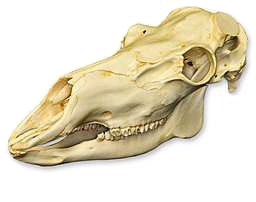Caribou
Caribou, or reindeer, are probably the most iconic Yukon animal today. Their history runs deep in the North—they evolved in Beringia as much as 2 million years ago. Caribou are a member of the diverse New World deer group, and out of all deer species they are the best adapted to the cold arctic climate. You may find it surprising to learn that scientists believe this iconic northern species has ancestry stretching back to South America, with their early ancestors moving north across the Isthmus of Panama about 5 million years ago.

mammals in the North.
Today, caribou can be found throughout the Circumpolar North, from Scandinavia to Greenland. In North America, these highly adaptable animals can be broadly divided into ecotypes that live above the arctic treeline (barren-ground caribou) and those that live withing the boreal forests (woodland caribou).
With a few exceptions, this division into barren-ground and woodland caribou is intimately linked to the fluctuating glacial and interglacial climates of the Ice Age. Around 300,000 years ago, during a relatively warm interglacial period caribou expanded throughout the northern half of North America. When temperatures began to cool and glaciers once again started to grow accross Canada, the expansive caribou range was split in two, with isolated caribou populations living north of the continental ice sheets in Beringia and others in a thin margin of suitable habitat along the southern edge of the continental glaciers. Remarkably, these two types of caribou appear to have remained isolated throughout the rest of the Ice Age.
Yukon's Long History of Caribou
The world's oldest known caribou remains were found in the Fort Selkirk region of central Yukon, dating back to 1.6 million years ago. Of the many ice age caribou bones, teeth and antlers recovered in Yukon, there are three particularily important specimens. Each of these three fossils—a lower leg bone and a fragment of an antler recovered from the Old Crow Basin, and another antler fragment from the Dawson City region—clearly show evidence of human use.
The two bones from Old Crow were initially thought to be about 25,000 to 27,000 years old, and at the time represented some of the earliest evidence of humans in North America. Those bones sparked the "Great Bone Rush" of the 1960s in the Old Crow region. Unfortunately, more recent work has shown that these bones are in fact much younger, dating to only about 1,000 years ago. Regardless of their age, one thing is clear from these culturally-modified remains: In Yukon, humans have been hunting and using caribou for as long as humans have been in the region. Today, caribou are one of the most significant wildlife species for northern First Nations.
Recent Discoveries

Scientists have used DNA from fossilized and recent bones to investigate how North American caribou have responded to the most recent climate cycles. Surprisingly, it appears that North American caribou populations were relatively low during the peak cold periods of the Ice Age. Their population began to expand at the end of the Pleistocene, a trend that continued as the climate warmed up to the present. This increase in population is mirrored by the studies showing an increase of suitable habitat for caribou as the ice sheets retreated. In a way, this suggests caribou are best suited for living in the North during the interglacial periods. Even so, studies of living caribou are suggesting that current climate change and the continued warming of the Arctic are starting to have strong negative impacts on modern caribou populations.
Want to learn more? Check out the Beringian Research Notes on ancient caribou.

